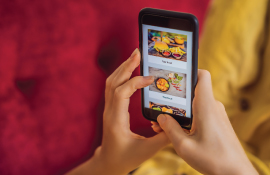The overview
The Covid-19 pandemic shook many industries overnight. The food industry was not spared. Restaurants across the world shut during the early days of the pandemic-induced lockdown. Many restaurants went out of business, and a few merely survived. The only way restaurants could survive the pandemic and make ends meet was by adapting contactless food deliveries. Foodies who loved searching for cozy and popular restaurants to relish a meal with their loved ones quickly started searching for safe and hygienic restaurants that offered door delivery. Taste, cuisine, variety took a back seat. The shift in consumer dining choices in the new normal was unprecedented. Opt-ins for meal kits and online food orders increased exponentially as going out of home was no longer the first preference. Processing food for home deliveries or takeaways in a no-touch/frictionless delivery model while maintaining utmost hygiene standards became critical for restaurants to maintain business viability in the pandemic and post-pandemic era.
Business challenges
- Responding to dynamic cultural shifts with agility – The cultural shift in consumer’s dining choices took a drastic change. In the new normal, consumers were no longer expected to start the day with tea/coffee in a café, have a delicious lunch at a bistro, stroll around to taste a fine cake in a Salon De Thé, and end the night with a lovely dinner at a brasserie. Instead, opt-ins for meal kits and online food orders increased exponentially, resulting in a decline in preference for variety and an increase in preference for safe and regular food choices.
- The transformation of restaurants to ghost kitchens: Dine-in kitchens were compelled to transform themselves to ghost kitchens overnight to process food for home deliveries or takeaways in a no-touch/frictionless delivery model while maintaining utmost hygiene standards.
- Ability to generate fast and cost-effective business visibility: Historically, restaurants did not leverage technology as a service model to reach out to customers actively. The majority of the customers came in for an in-person dine-in experience while aggregators tackled home deliveries. In the post-COVID-19 world, plummeting dine-in visits pushed restaurant operators to focus more on takeaways and home deliveries.
- Great focus on hygiene: Adherence to WHO standards on food safety have become the key for foodservice businesses to regain customer trust. Given this scenario, restaurants are more eager than ever to leverage technology to ramp up positive visibility, generate user awareness, and process orders.
Recognizing that thousands of local restaurants would be losing profit margin and business viability by joining existing delivery service applications that take 15-30% commission, a leading foodservice giant collaborated with Mindtree to create a free hyperlocal digital platform to connect millions of consumers with local, nearby restaurants.
The solution
The digital application helps restaurants to quickly and easily promote their delivery takeaway offerings to consumers in the locality. More importantly, since the application is free, the revenue from the local orders goes to the restaurant directly, without having to pay any commission to the order aggregators. The application enabled customers to get food delivered during the lockdown and supported the local community by making local restaurants regain business viability.
Solution key highlights
- A cost-effective platform: Mindtree actively collaborated with the client to build the application leveraging state-of-the-art agile and development practices. This resulted in getting the site live, and the initial campaign rolled out with an expense of just 10K EUR.
- Fast time to market: From designing to implementing the technology solutions, all activities happened in a couple of weeks for the first market rollout. The implementation was quick and seamless.
- A scalable offering: This scalable application transcended all platform and language challenges using differentiated strategy and delivery execution.
- Empathetic UX design: Easy human interactivity with high customer experience was at the core of the design. An uncluttered user interface empowered customers to engage with the platform without a steep learning curve. On the other hand, it also enabled restaurants to onboard without requiring any prior technological expertise, without any cost factor.
Within the first six months of the pandemic, the application went live in four global markets and supported close to 10K restaurants. Restaurants have continued to thrive and grow despite the gradual relaxation of the lockdown and restaurants opening for dine-in orders. Below have been some of the most salient benefits of this application:
- Market penetration: Bespoke marketing campaigns and easy user adoption have led to an exponential increase in the user base. 80%-90% of the restaurants that signed up were previously unknown to the client, helping the client gain deeper insight into local restaurants across the markets.
- Lead conversion: 60%-70% of the signed-up restaurants have also opted-in to receive communications via emails and other channels. This helped the client convert these to leads by targeting them with targeted products and services.
- Underlying sales growth: While it is too soon to measure new business traction effectively, with close to 10K restaurants signing up across four countries, the application is already acting as a valuable lead generator for the client with very high new restaurant sign-ups.
- Data modeling for better CX – Integration with data lakes and marketing campaign systems has made it possible to create accurate predictive models for personalized customer experience. The outcome is improved customer stickiness and loyalty, increased basket size, and high conversion rates.
The biggest beneficiaries of the application are local communities: consumers and local restaurants. With the easy discoverability of local restaurants, millions of consumers across geographies get local food delivered to their doorsteps, while thousands of restaurants have got a new lease of life in what was otherwise a very difficult year for the food services industry.
Download Case Study to read more

